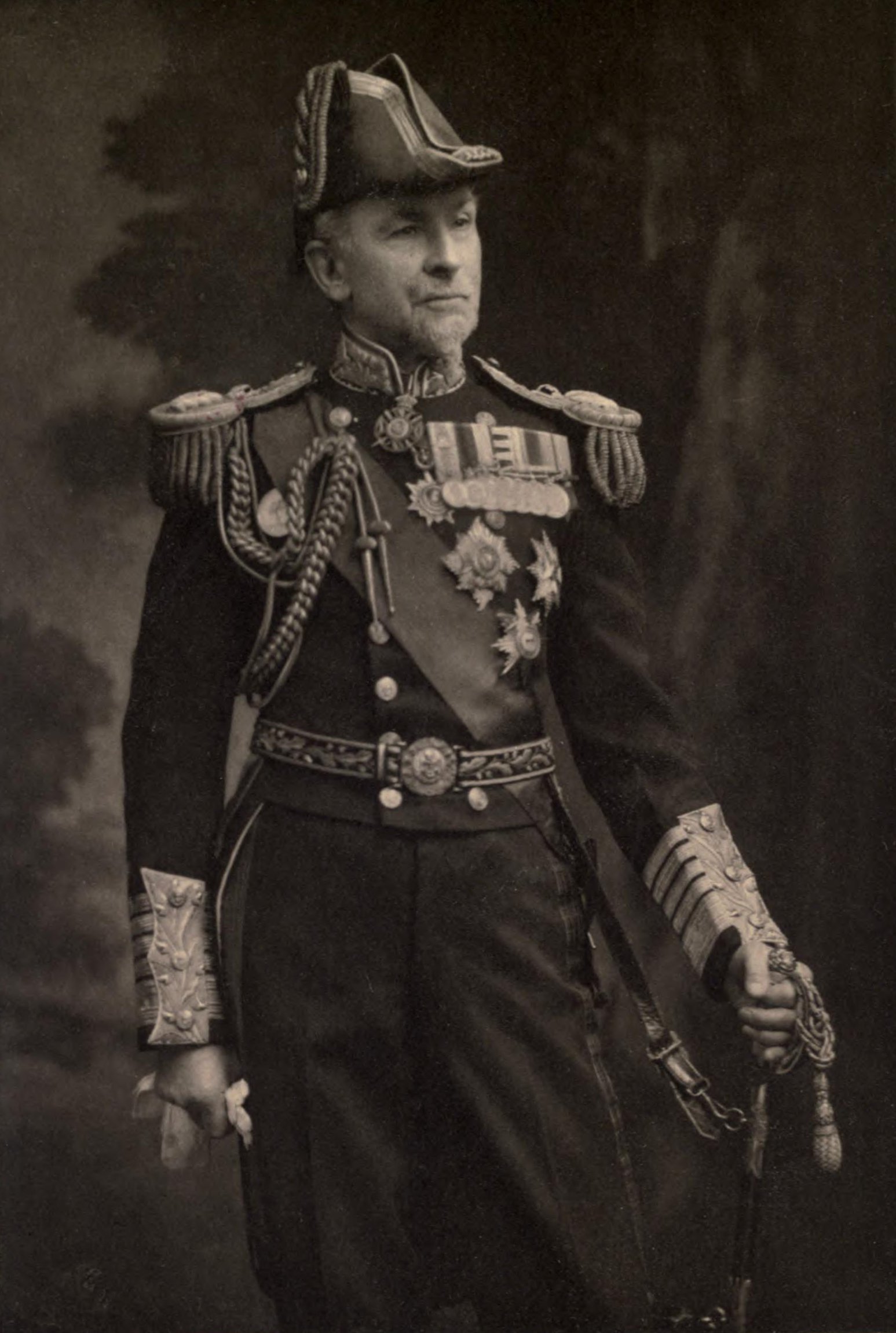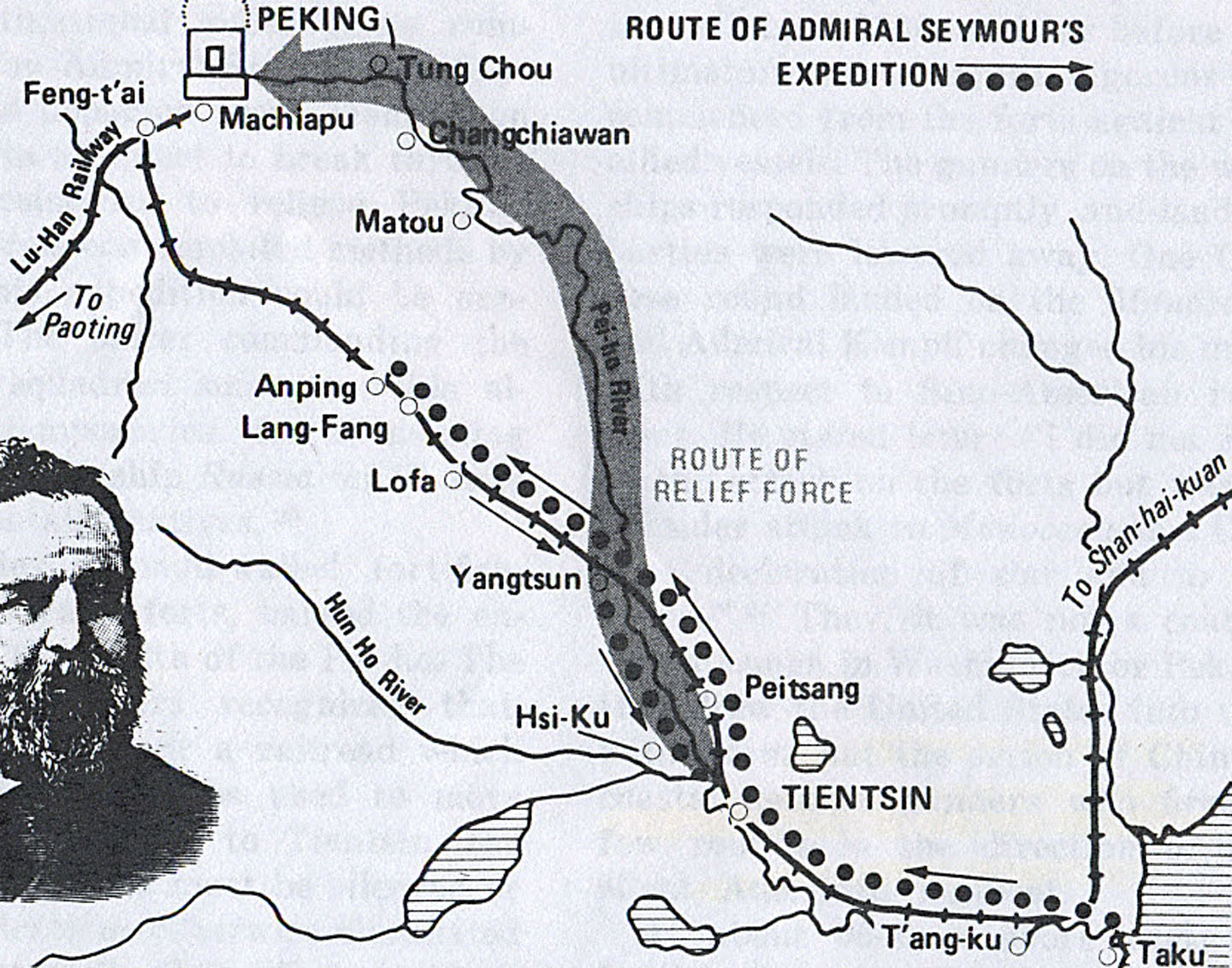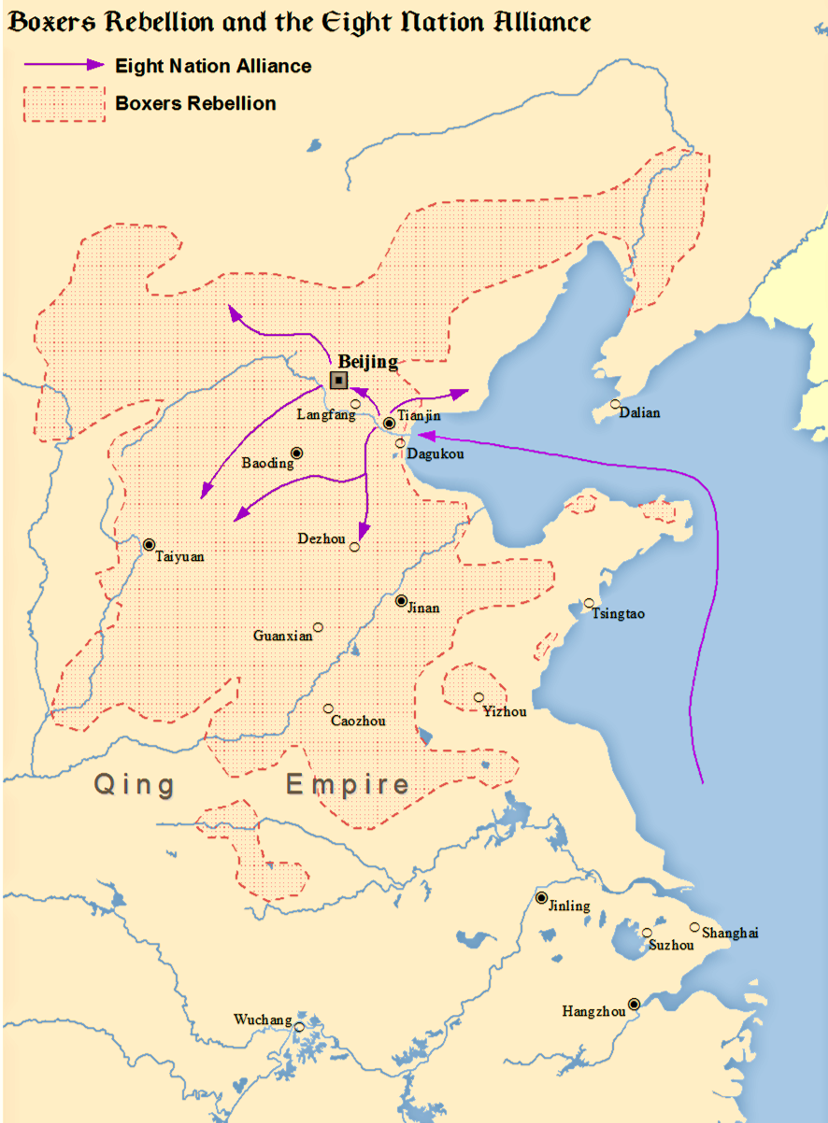First Intervention, Seymour Expedition, China 1900 on:
[Wikipedia]
[Google]
[Amazon]
The Seymour Expedition () was an attempt by a multinational military force led by Admiral Edward Seymour to march to
 Boxer bands advanced on Beijing in May and June 1900. The Qing court was ambivalent about the Boxers, fearing that they might become anti-Qing. The Boxers became a serious threat to Western and Japanese citizens, murdering missionaries and Chinese Christians living northern China. The diplomatic legations in Beijing requested that guards be sent to protect them. As such, more than 400 marines and naval troops from eight countries arrived in Beijing on 31 May. However, as the Boxers began posing a more significant threat, it became apparent that additional troops were needed. On 9 June, Sir
Boxer bands advanced on Beijing in May and June 1900. The Qing court was ambivalent about the Boxers, fearing that they might become anti-Qing. The Boxers became a serious threat to Western and Japanese citizens, murdering missionaries and Chinese Christians living northern China. The diplomatic legations in Beijing requested that guards be sent to protect them. As such, more than 400 marines and naval troops from eight countries arrived in Beijing on 31 May. However, as the Boxers began posing a more significant threat, it became apparent that additional troops were needed. On 9 June, Sir
 Seymour commandeered five trains in Tianjin and departed for Beijing with his entire force on the morning of 10 June. On the first day, the soldiers travelled 25 miles without incident, crossing a bridge at Yancun over the
Seymour commandeered five trains in Tianjin and departed for Beijing with his entire force on the morning of 10 June. On the first day, the soldiers travelled 25 miles without incident, crossing a bridge at Yancun over the
 Gen. Dong Fuxiang, along with his Kansu (Chinese Muslim) Braves, prepared to ambush the invading western army. Gen.
Gen. Dong Fuxiang, along with his Kansu (Chinese Muslim) Braves, prepared to ambush the invading western army. Gen.
Beijing
Beijing, Chinese postal romanization, previously romanized as Peking, is the capital city of China. With more than 22 million residents, it is the world's List of national capitals by population, most populous national capital city as well as ...
and relieve the Siege of the Legations from attacks by Qing China
The Qing dynasty ( ), officially the Great Qing, was a Manchu-led imperial dynasty of China and an early modern empire in East Asia. The last imperial dynasty in Chinese history, the Qing dynasty was preceded by the Ming dynasty ...
government troops and the Boxers in 1900. The Chinese and Boxer fighters defeated the Seymour armies and forced them to return to Tianjin
Tianjin is a direct-administered municipality in North China, northern China on the shore of the Bohai Sea. It is one of the National Central City, nine national central cities, with a total population of 13,866,009 inhabitants at the time of the ...
(Tientsin). It was followed later in the summer by the successful Gaselee Expedition
The Gaselee Expedition was a successful relief by a multi-national military force to march to Beijing and protect the diplomatic legations and foreign nationals in the city from attacks in 1900. The expedition was part of the war of the Boxer Re ...
.
Historical background
 Boxer bands advanced on Beijing in May and June 1900. The Qing court was ambivalent about the Boxers, fearing that they might become anti-Qing. The Boxers became a serious threat to Western and Japanese citizens, murdering missionaries and Chinese Christians living northern China. The diplomatic legations in Beijing requested that guards be sent to protect them. As such, more than 400 marines and naval troops from eight countries arrived in Beijing on 31 May. However, as the Boxers began posing a more significant threat, it became apparent that additional troops were needed. On 9 June, Sir
Boxer bands advanced on Beijing in May and June 1900. The Qing court was ambivalent about the Boxers, fearing that they might become anti-Qing. The Boxers became a serious threat to Western and Japanese citizens, murdering missionaries and Chinese Christians living northern China. The diplomatic legations in Beijing requested that guards be sent to protect them. As such, more than 400 marines and naval troops from eight countries arrived in Beijing on 31 May. However, as the Boxers began posing a more significant threat, it became apparent that additional troops were needed. On 9 June, Sir Claude Maxwell MacDonald
Colonel Sir Claude Maxwell MacDonald, (12 June 1852 – 10 September 1915) was a British soldier and diplomat, best known for his service in China, Korea, and Japan.
Early life
MacDonald was born the son of Mary Ellen MacDonald (''nee'' Dougan ...
, the British Minister in China, cabled Vice-Admiral Edward Hobart Seymour
Admiral of the Fleet Sir Edward Hobart Seymour, (30 April 1840 – 2 March 1929) was a Royal Navy officer. As a junior officer he served in the Black Sea during the Crimean War. He then took part in the sinking of the war-junks, the Battle of C ...
, commander of the British navy's China Station
The Commander-in-Chief, China, was the admiral in command of what was usually known as the China Station, at once both a British Royal Navy naval formation and its admiral in command. It was created in 1865 and deactivated in 1941.
From 1831 to 1 ...
, that the situation in Beijing was becoming more serious and that troops should be landed with all arrangements made for an advance to Peking eijingat once.
Responding to MacDonald's message, Seymour assembled in 24 hours a force of more than 2,000 sailors and marines from European, American, and Japanese warships. He prepared to embark for Beijing by train from Tianjin, 75 miles away. His force consisted of 916 British, 455 Germans, 326 Russians, 158 French, 112 Americans, 54 Japanese, 41 Italians, and 26 Austrians. Seymour's Chief of Staff was Capt. John Jellicoe.
The diplomats in Beijing anticipated that Seymour would arrive on 11 June. They neither requested the imperial court's permission nor informed the court of their intentions. They had, in effect, launched an invasion.
Advance toward Beijing
 Seymour commandeered five trains in Tianjin and departed for Beijing with his entire force on the morning of 10 June. On the first day, the soldiers travelled 25 miles without incident, crossing a bridge at Yancun over the
Seymour commandeered five trains in Tianjin and departed for Beijing with his entire force on the morning of 10 June. On the first day, the soldiers travelled 25 miles without incident, crossing a bridge at Yancun over the Hai River
The Hai River (海河, lit. "Sea River"), also known as the Peiho, ("White River"), or Hai Ho, is a Chinese river connecting Beijing to Tianjin and the Bohai Sea.
During the Song dynasty, the main stream of the Hai River was called the lowe ...
unopposed; although Chinese Gen. Nie Shicheng
Nie Shicheng (; 1836 – July 1900) was a Chinese general of the Qing dynasty who served the imperial government during the Boxer Rebellion. Rising from obscure origins from Hefei, Anhui Province, in the early 1850s, Nie Shicheng managed to ...
and thousands of his soldiers were camped there, Nie's soldiers were friendly and did not attack. Nie had let Seymour's army slip past because he had deliberately been issued contradictory orders by Ronglu
Ronglu (6 April 1836 – 11 April 1903), courtesy name Zhonghua, was a Manchu political and military leader of the late Qing dynasty. He was born in the Guwalgiya clan, which was under the Plain White Banner of the Manchu Eight Banners. D ...
, a Manchu political and military leader who was working to derail the efforts to capture the legations. The next few days went slowly, as Seymour had to repair railroad tracks and fight off Boxer attacks as his trains advanced. On 14 June, several hundred Boxers armed with swords, spears, and gingals attacked Seymour twice and killed five Italian soldiers. The Americans counted 102 Boxer bodies left on the battlefield at the end of one battle.
The Chinese government had reversed its earlier positions after learning of the invasion, deciding to absorb the Boxer forces and order the army to defend against Seymour's march to the capital.
Battle of Langfang
 Gen. Dong Fuxiang, along with his Kansu (Chinese Muslim) Braves, prepared to ambush the invading western army. Gen.
Gen. Dong Fuxiang, along with his Kansu (Chinese Muslim) Braves, prepared to ambush the invading western army. Gen. Ma Fuxiang
Ma Fuxiang (, Xiao'erjing: , French romanization: Ma-Fou-hiang or Ma Fou-siang; 4 February 1876 – 19 August 1932) was a Chinese Muslim scholar and military and political figure, spanning from the Qing Dynasty through the early Republic of ...
and Gen. Ma Fulu
Ma Fulu ( zh, s=马福禄, p=Mǎ Fúlù, Xiao'erjing: ; 1854 – 1900) was a Chinese Muslim general of the Hui people, Hui ethnic group who served under the Qing dynasty. The son of General Ma Qianling and the brother of Ma Fucai, Ma Fushou a ...
personally planned and led the attack, with a pincer movement around the European force. On 18 June, Dong Fuxiang's troops, stationed at Hunting Park in southern Beijing, attacked at multiple points, including Langfang. The force of 5,000 included cavalrymen armed with modern rifles. The foreign troops, especially the Germans, fought off the attack, killing hundreds of Chinese at a loss of seven dead and 57 wounded. The Kansu Braves lost 200 and the Boxers another 200. The need to care for the wounded, a lack of supplies, and the likelihood of additional Chinese attacks led Seymour and his officers to decide to retreat to Tianjin. The Chinese army's unexpected attack on Seymour was a response to the European and Japanese attack on the Dagu Forts
The Taku Forts or Dagukou Forts (大沽口炮台), also called the Peiho Forts are forts located by the Hai River (Peiho River) estuary in the Binhai New Area, Tianjin, in northeastern China. They are located southeast of the Tianjin urban c ...
two days previously; combined with news of Seymour's incursion, the formally neutral Qing government threw its full support behind the Boxer movement.
During one of the battles at Langfang, Boxers armed with swords and spears charged the British and American troops. The British were armed with .303 Lee–Metford
The Lee–Metford (also known as the Magazine Lee–Metford) is a British bolt action rifle which combined James Paris Lee's rear-locking bolt system and detachable magazine with an innovative seven-groove rifled barrel designed by William Ell ...
rifles, while the Americans carried with them the M1895 Lee Navy
The M1895 Lee Navy was a straight-pull magazine rifle adopted in limited numbers by the U.S. Navy and Marine Corps in 1895 as a first-line infantry rifle.Walter, John, ''The Rifle Story: An Illustrated History from 1776 to the Present Day'', MBI ...
. At point-blank range, one British soldier had to fire four bullets into a Boxer before he stopped; the American commander, Bowman McCalla, also reported that his men had witnessed Boxers sustaining multiple bullet wounds before dying.
The retreat
Seymour turned his five trains around and headed back toward Tianjin. However, he found that either the Boxers or the Chinese Army had destroyed the bridge across the Hai River he had crossed previously. The expedition would either have to cross the river by boat and walk eighteen miles to Tianjin along the railroad or follow the river for a longer route of 30 miles. The sailors, perhaps more comfortable near water, chose to follow the river; Seymour did not challenge their decision despite the overland route being shorter and less exposed. Seymour's retreat down the Hai River was slow and difficult, covering only three miles the first day. The riverbanks were densely populated with civilians sympathetic to the Boxers who ambushed the soldiers as they passed and caused further delays. Additional casualties included Capt. Jellicoe, who suffered a near-fatal wound. By 22 June, the soldiers were out of food and down to fewer than 10 rounds of ammunition per man; only the Americans had thought to pack additional rounds. However, they reportedly never considered surrendering. On 23 June, six miles from Tianjin, Seymour came across the Chinese army's Xigu fort and arsenal which, inexplicably, was nearly undefended. The foreign soldiers were quick to shelter inside, looting the arsenal's supplies of food and replacing their weapons and ammunition. Realizing their mistake in leaving the arsenal undefended, the pursuing Chinese army attempted to dislodge Seymour's forces, which were now well provisioned and so repelled the Chinese attacks. A Chinese servant of the British slipped through to Tianjin and raised the alarm. A force of 2,000 soldiers marched out of the city to the arsenal on 25 June, and escorted Seymour's men back to Tianjin the next day. The Chinese did not oppose their passage. A missionary reported their arrival in Tianjin: "I shall never forget to my dying day, the long string of dusty travel-worn soldiers, who for a fortnight had been living on quarter rations, and fighting every day . . . the men were met by kind ladies with pails of tea which the poor fellows drunk as they had never drunk before – some bursting into tears." Of the initial 2,000 men in the Seymour expedition, there were 62 dead and 232 wounded. The besieged foreigners in the legations in Beijing, unaware of the defeat, held out hope for several weeks after that Seymore would come to their aid. Even the Chinese government were initially unaware of the victory.Assessment
The Seymour expedition was described in foreign media as a "serious failure" and a "humiliation". Seymour had underestimated his Chinese opponent, trusting that he could push through to Beijing quickly with little or no opposition. Instead, "Seymour's expedition became a large moving target for the Boxers and Imperial troops. The would-be rescuers ... required rescue themselves." The Western and Japanese soldiers and civilians in Beijing were left to withstand a 55-day siege by the Boxers and their Qing allies. It took more than a month after the Seymour expedition for theEight-Nation Alliance
The Eight-Nation Alliance was a multinational military coalition that invaded northern China in 1900 during the Boxer Rebellion, with the stated aim of relieving the foreign legations in Beijing, which were being besieged by the popular Boxer ...
to organize a larger and better-equipped army to defeat the Chinese and march on Beijing in order to relieve the siege of the legation quarter
The Peking Legation Quarter was the area in Beijing (Peking), China where a number of foreign legations were located between 1861 and 1959. In the Chinese language, the area is known as ''Dong Jiaomin Xiang'' (), which is the name of the ''hutong ...
.
Compared to the well-armed and trained Western forces, the Boxers had only limited quantities of firearms and largely fought with spears and swords; most of them were boys and common peasants who would simply charge directly into rifle fire without protection. Yet they fought with unmatched courage and determination, sometimes even faking death before springing back up when the enemy approached; an Allied soldier, Bigham, said they had no "fear" or "hesitation".
The expedition failed for several reasons, chief among them being overconfidence on the part of the Westerners, who regarded the Chinese as cowards and barbarians with no fighting skill; thus, the expedition was lightly armed and supplied on the assumption that reaching Beijing would be a matter of days.
The ''Spectator
''Spectator'' or ''The Spectator'' may refer to:
*Spectator sport, a sport that is characterized by the presence of spectators, or watchers, at its matches
*Audience
Publications Canada
* '' The Hamilton Spectator'', a Hamilton, Ontario, Canada, ...
'' pointed out that the expedition was "to embark on the assumption that any force of Europeans however small can beat any force of Chinamen however large." Further reasons include the loss of communication between the expedition and the Tianjin command due to Boxer sabotage of telegraph lines, the over-reliance on rail transport coupled with a failure to guard the railway (which allowed the bridge to be destroyed and rendered the trains useless), and the overall lack of strategic planning and vision of Admiral Seymour.
Notes
References
* * * * Thompson, Larry Clinton (2009), ''William Scott Ament and the Boxer Rebellion: Heroism, Hubris, and the Ideal Missionary'', Jefferson, NC: McFarland Publishing Company. * {{DEFAULTSORT:Seymour, Expedition Conflicts in 1900 Battles of the Boxer Rebellion involving the United States 1900 in China Battles of the Boxer Rebellion United States Marine Corps in the 20th century Anti-imperialism in Asia June 1900